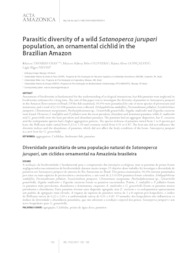Parasitic diversity of a wild Satanoperca jurupari population, an ornamental cichlid in the Brazilian Amazon.
Parasitic diversity of a wild Satanoperca jurupari population, an ornamental cichlid in the Brazilian Amazon.
Author(s): TAVARES-DIAS, M.; OLIVEIRA, M. S. B.; GONÇALVES, R. A.; NEVES, L. R.
Summary: Assessment of biodiversity is fundamental for the understanding of ecological interactions, but fish parasites were neglected in biodiversity estimates for a long time. The aim of this paper was to investigate the diversity of parasites in Satanoperca jurupari in the Amazon River system in Brazil. Of the fish examined, 90.0% were parasitized by one or more species of protozoans and metazoans, and a total of 3,110,094 parasites were collected. Ichthyophthirius multifiliis, Piscinoodinium pillulare, Sciadicleithum juruparii, Clinostomum marginatum, Posthodiplostomum sp., Genarchella genarchella, Argulus multicolor and Ergasilus coatiarus were found. However, I. multifiliis and P. pillulare were the most prevalent, abundant and dominant parasites, while A. multicolor and G. genarchella were the least prevalent and abundant parasites. The parasites had an aggregate dispersion, but E. coatiarus and the endoparasite species had a higher aggregation pattern. The species richness of parasites varied from 1 to 8 species per host, the Brillouin index varied from 0.32 to 1.09 and evenness varied from 0.01 to 0.47. The host size did not influence the diversity indices and the abundance of parasites, which did not affect the body condition of the hosts. Satanoperca jurupari is a new host for G. genarchella.
Publication year: 2017
Types of publication: Journal article
Unit: Embrapa Amapá
Keywords: Aggregation, Agregação, Freshwater fish, Parasite, Parasito, Peixe de água doce
Observation
Some of Embrapa's publications are published as ePub files. To read them, use or download one of the following free software options to your computer or mobile device. Android: Google Play Books; IOS: iBooks; Windows and Linux: Calibre.
Access other publications
Access the Agricultural Research Database (BDPA) to consult Embrapa's full library collection and records.
Visit Embrapa Bookstore to purchase books and other publications sold by Embrapa.

